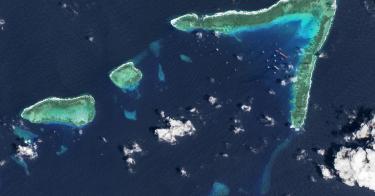As the Biden administration strives to reinforce ties with key Asian allies from India to Japan, tensions in the South China Sea region are again on the rise.
Both the Philippines and Vietnam have expressed concern as hundreds of Chinese fishing boats congregate near Whitsun Reef in the Spratly islands. China has used such fishing fleets in the past to help seize control of other disputed islands and otherwise press its claims. Many of these fishing boats do double duty as part of China’s extensive maritime militia in a new expression of “people’s war at sea,” especially in the South China Sea.
Beijing has increasingly asserted its sovereignty claims over the past decade. In 2009, several U.S. ships were harassed by Chinese fishing boats trying to drive off the American presence. These incidents at sea have steadily escalated, as U.S. Navy ships sailing in the South China Sea have repeatedly had near-collisions with Chinese surface combatants, including the USS Cowpens in 2013 and the USS Decatur in 2018.
Meanwhile, China has built artificial islands atop several of the reefs that it controls, wreaking environmental havoc in the process. These new islands total some 3,200 acres, dwarfing all other land reclamation in the area by orders of magnitude. Three of these new islands now boast 10,000-foot runways, sufficient to support large airliners—or high performance combat aircraft. Artillery and missile emplacements have been identified on them.
>>> The China Transparency Project
From Beijing’s perspective, all of this is simply a matter of defending Chinese territorial sovereignty. After all, Chinese fishermen have been plying these waters for thousands of years. And the “Nine Dash Line” that forms the basis for China’s claim to these waters was imposed by Chiang Kai-shek and the Nationalists in the 1940s, before the People’s Republic of China was even established. The Chinese describe their maritime sovereignty claims as defending “blue soil,” implying that they would defend these claims much like they would defend sovereignty on land—with force if necessary.
But the PRC’s claims are easily the most expansive. While other nations claim, per the UN Convention on the Law of the Sea (UNCLOS), a 200-mile “exclusive economic zone” extending from their shores, China’s “Nine Dash Line” would give Beijing control over waters far more distant.
China claims almost the entire South China Sea, the carotid artery of global trade, with some $5 trillion worth of shipping and goods passing through. The impact of even a week’s delay in shipping has been seen with the Suez Canal blockage; the impact of interference with the South China Sea would be at least as bad.
Furthermore, Beijing interprets the “Nine Dash Line” as extending to within a few miles of the coasts of the Philippines and Vietnam. These nations would be denied even the right to a 12-mile stretch of territorial waters if China had its way. In 2015, the Philippines took the Chinese to international court, asking the Permanent Court of Arbitration (PCA) headquartered in The Hague to review the competing claims. The PCA concluded that China’s claims were invalid. Beijing has ignored the ruling.
As China has demonstrated in its behavior toward Hong Kong, it has little regard for treaties when it comes to issues of national sovereignty. It undoubtedly sees the South China Sea as just such an issue, having described it as a “core interest,” a term that is liberally applied to Taiwan and Xinjiang.
For President Biden, the South China Sea is a “known known.” The Chinese outmaneuvered the Obama administration when it came to Scarborough Shoal, also in the South China Sea, when they got the White House to push the Philippines to withdraw from the reef while remaining there themselves. The Obama administration also halted Freedom of Navigation operations in the South China Sea for three years, while China built its islands.
Undoubtedly, the Chinese would love to see a replay of those policies, especially in exchange for vague promises on climate change. Given the Biden administration’s insistence on the centrality of climate change, Beijing may well believe that this White House will make quiet concessions on the South China Sea, in exchange for renewed promises of eventual cutbacks in Chinese greenhouse gas emissions. (Someone might want to remind climate czar John Kerry that in 2020 China brought on line more coal-fired electricity than three times the rest of the world combined.)
Former President Donald Trump’s administration held regular Freedom of Navigation Operations, one every other month or so, as a clear signal of American interest in the region. Biden should continue the practice.
Lenin famously said, “You probe with bayonets. If you find mush, you proceed. If you find steel, you withdraw.”
In Anchorage, China’s senior diplomats made clear that they could buffalo their counterparts, disregarding agreed-upon time limits, and chastising America for not treating their “guests” with more respect even while acting in an insulting manner.
The South China Sea is likely to be one of the areas where Beijing probes to see whether the U.S. is mush or steel.
This piece originally appeared in the New York Post


